Leadership Style at Apple and Personal Learning Plan
VerifiedAdded on 2022/11/13
|15
|3452
|70
AI Summary
This document discusses the leadership style at Apple and personal learning plan. It provides insights into Tim Cook's style of leadership and the seven capabilities of personal learning plan. It also talks about SMART objectives and more.
Contribute Materials
Your contribution can guide someone’s learning journey. Share your
documents today.
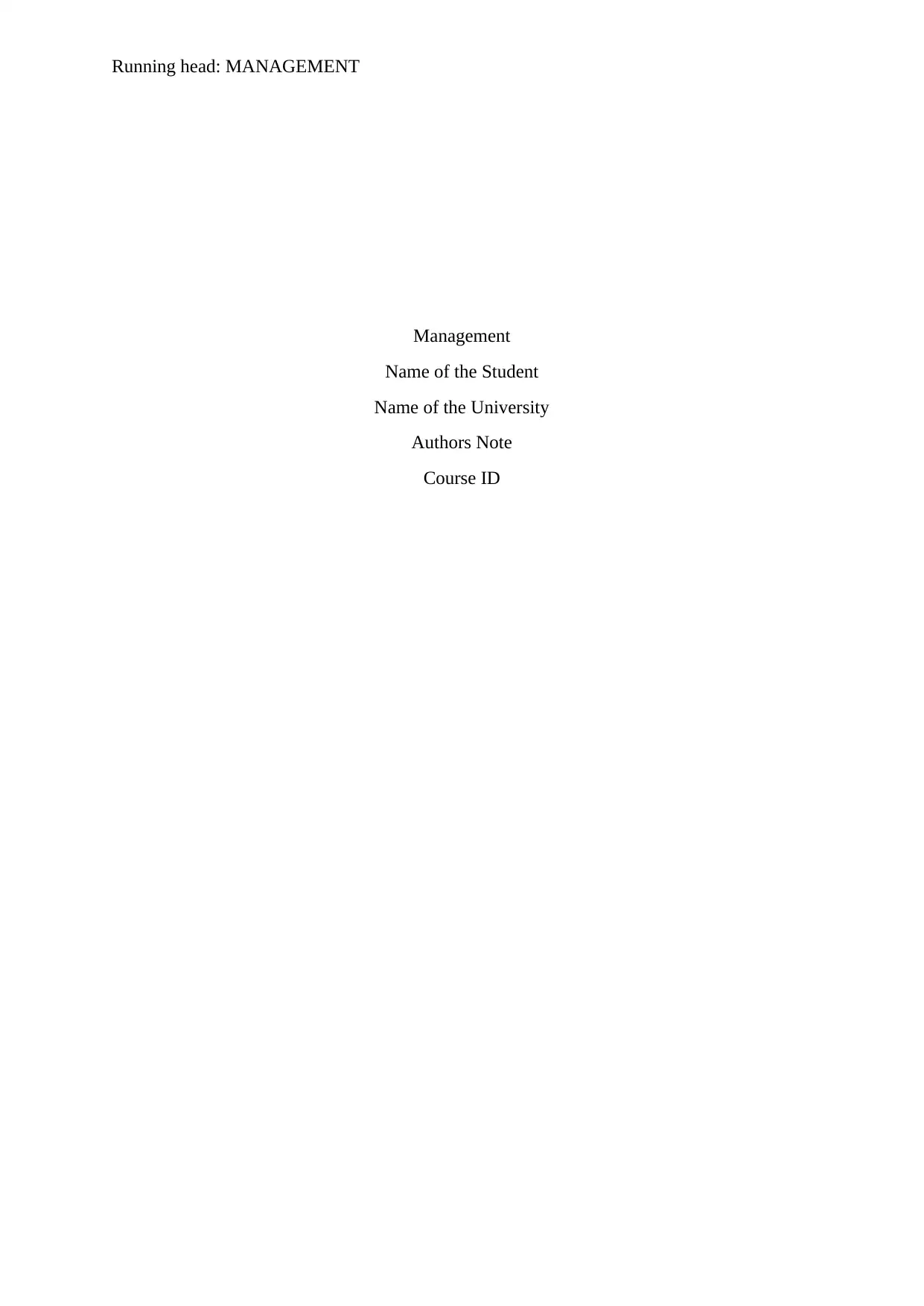
Running head: MANAGEMENT
Management
Name of the Student
Name of the University
Authors Note
Course ID
Management
Name of the Student
Name of the University
Authors Note
Course ID
Secure Best Marks with AI Grader
Need help grading? Try our AI Grader for instant feedback on your assignments.
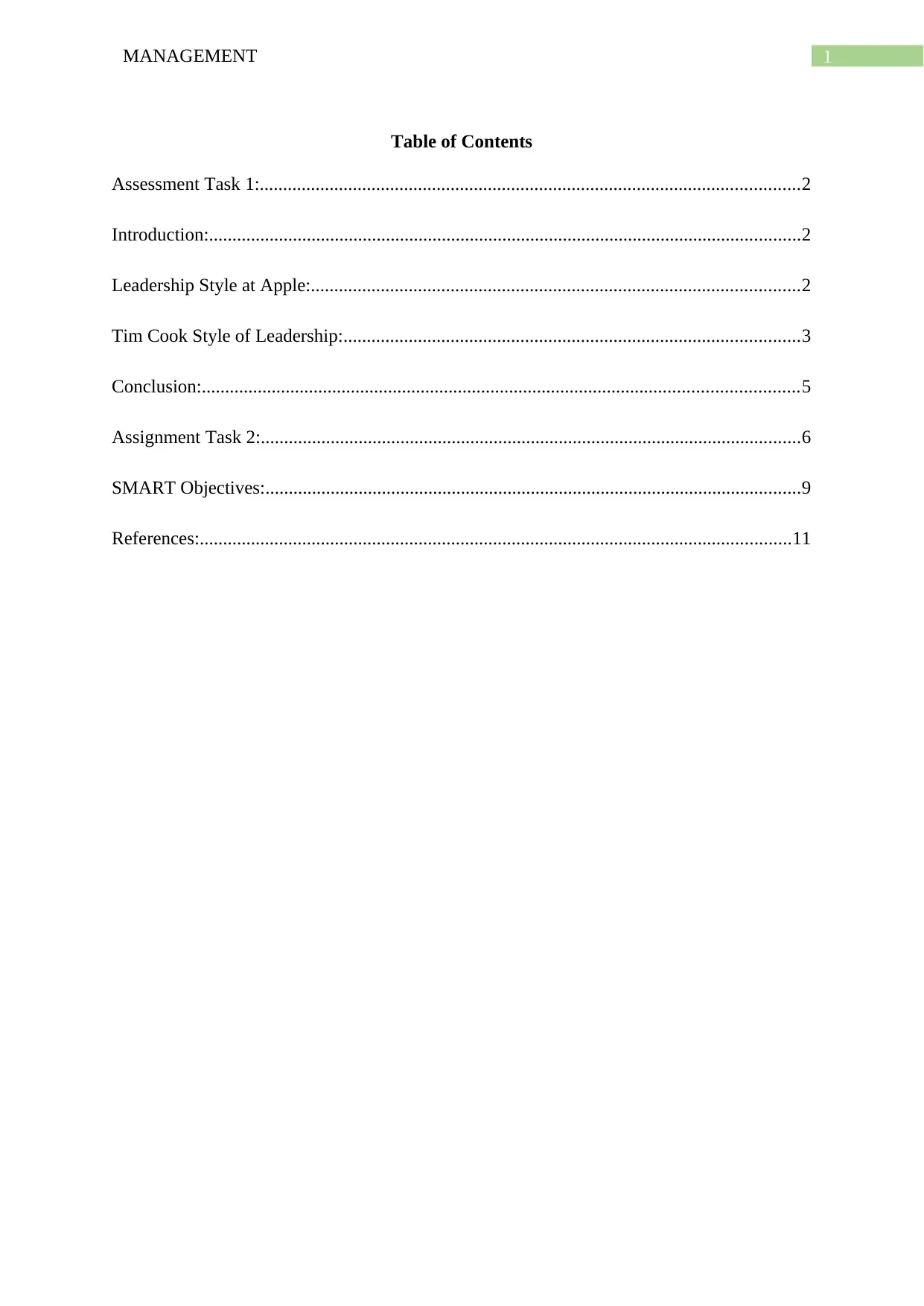
1MANAGEMENT
Table of Contents
Assessment Task 1:....................................................................................................................2
Introduction:...............................................................................................................................2
Leadership Style at Apple:.........................................................................................................2
Tim Cook Style of Leadership:..................................................................................................3
Conclusion:................................................................................................................................5
Assignment Task 2:....................................................................................................................6
SMART Objectives:...................................................................................................................9
References:...............................................................................................................................11
Table of Contents
Assessment Task 1:....................................................................................................................2
Introduction:...............................................................................................................................2
Leadership Style at Apple:.........................................................................................................2
Tim Cook Style of Leadership:..................................................................................................3
Conclusion:................................................................................................................................5
Assignment Task 2:....................................................................................................................6
SMART Objectives:...................................................................................................................9
References:...............................................................................................................................11
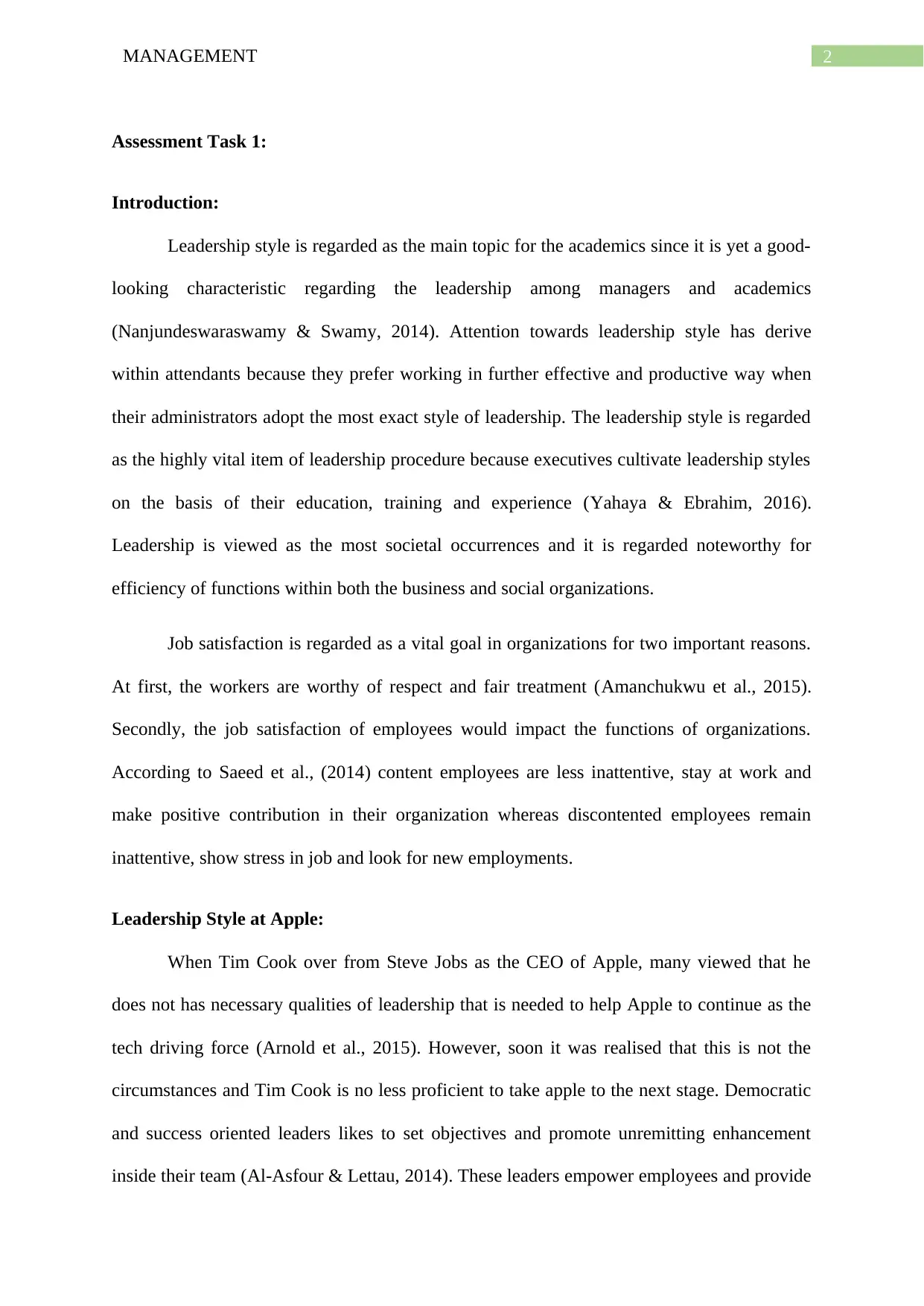
2MANAGEMENT
Assessment Task 1:
Introduction:
Leadership style is regarded as the main topic for the academics since it is yet a good-
looking characteristic regarding the leadership among managers and academics
(Nanjundeswaraswamy & Swamy, 2014). Attention towards leadership style has derive
within attendants because they prefer working in further effective and productive way when
their administrators adopt the most exact style of leadership. The leadership style is regarded
as the highly vital item of leadership procedure because executives cultivate leadership styles
on the basis of their education, training and experience (Yahaya & Ebrahim, 2016).
Leadership is viewed as the most societal occurrences and it is regarded noteworthy for
efficiency of functions within both the business and social organizations.
Job satisfaction is regarded as a vital goal in organizations for two important reasons.
At first, the workers are worthy of respect and fair treatment (Amanchukwu et al., 2015).
Secondly, the job satisfaction of employees would impact the functions of organizations.
According to Saeed et al., (2014) content employees are less inattentive, stay at work and
make positive contribution in their organization whereas discontented employees remain
inattentive, show stress in job and look for new employments.
Leadership Style at Apple:
When Tim Cook over from Steve Jobs as the CEO of Apple, many viewed that he
does not has necessary qualities of leadership that is needed to help Apple to continue as the
tech driving force (Arnold et al., 2015). However, soon it was realised that this is not the
circumstances and Tim Cook is no less proficient to take apple to the next stage. Democratic
and success oriented leaders likes to set objectives and promote unremitting enhancement
inside their team (Al-Asfour & Lettau, 2014). These leaders empower employees and provide
Assessment Task 1:
Introduction:
Leadership style is regarded as the main topic for the academics since it is yet a good-
looking characteristic regarding the leadership among managers and academics
(Nanjundeswaraswamy & Swamy, 2014). Attention towards leadership style has derive
within attendants because they prefer working in further effective and productive way when
their administrators adopt the most exact style of leadership. The leadership style is regarded
as the highly vital item of leadership procedure because executives cultivate leadership styles
on the basis of their education, training and experience (Yahaya & Ebrahim, 2016).
Leadership is viewed as the most societal occurrences and it is regarded noteworthy for
efficiency of functions within both the business and social organizations.
Job satisfaction is regarded as a vital goal in organizations for two important reasons.
At first, the workers are worthy of respect and fair treatment (Amanchukwu et al., 2015).
Secondly, the job satisfaction of employees would impact the functions of organizations.
According to Saeed et al., (2014) content employees are less inattentive, stay at work and
make positive contribution in their organization whereas discontented employees remain
inattentive, show stress in job and look for new employments.
Leadership Style at Apple:
When Tim Cook over from Steve Jobs as the CEO of Apple, many viewed that he
does not has necessary qualities of leadership that is needed to help Apple to continue as the
tech driving force (Arnold et al., 2015). However, soon it was realised that this is not the
circumstances and Tim Cook is no less proficient to take apple to the next stage. Democratic
and success oriented leaders likes to set objectives and promote unremitting enhancement
inside their team (Al-Asfour & Lettau, 2014). These leaders empower employees and provide
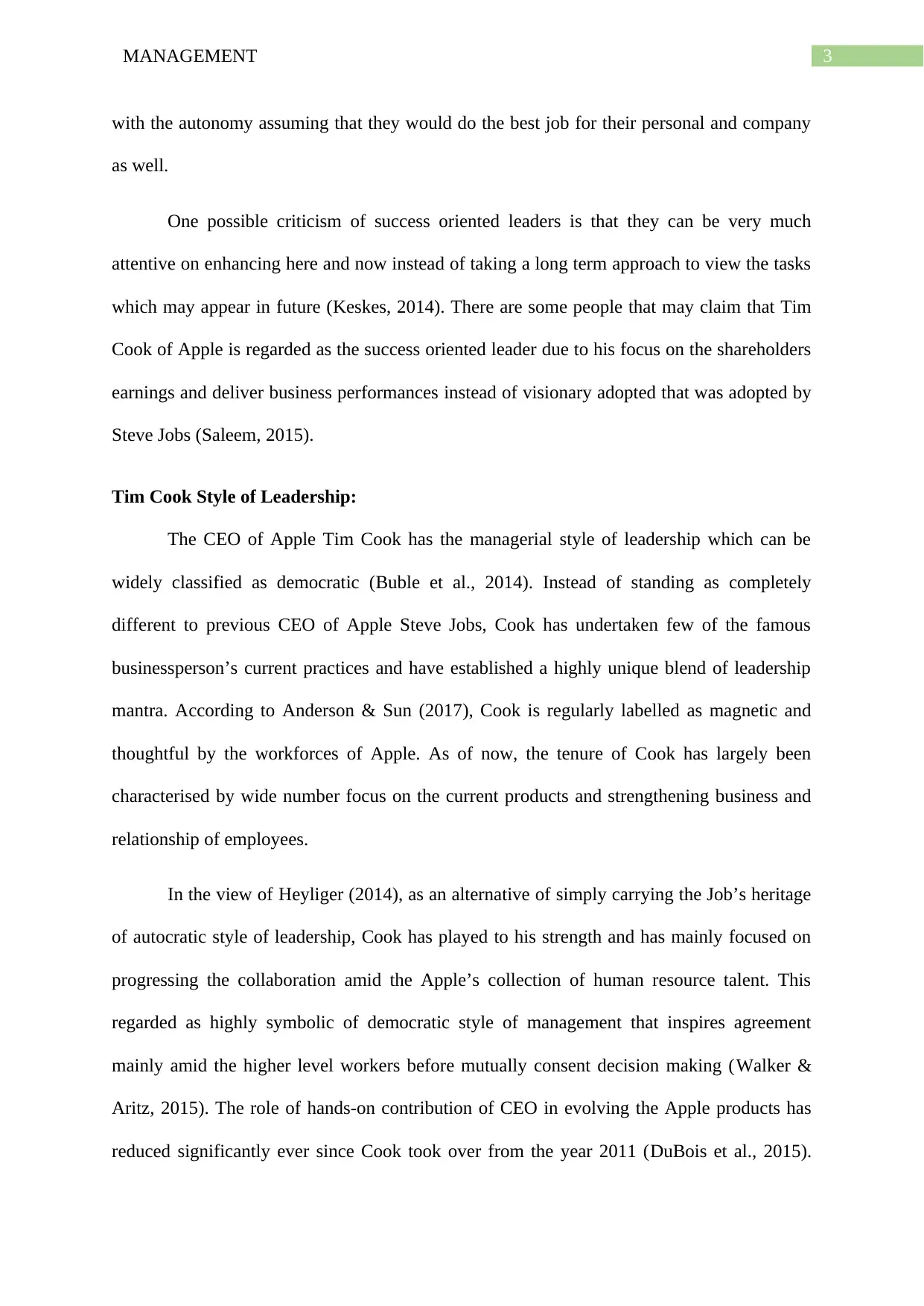
3MANAGEMENT
with the autonomy assuming that they would do the best job for their personal and company
as well.
One possible criticism of success oriented leaders is that they can be very much
attentive on enhancing here and now instead of taking a long term approach to view the tasks
which may appear in future (Keskes, 2014). There are some people that may claim that Tim
Cook of Apple is regarded as the success oriented leader due to his focus on the shareholders
earnings and deliver business performances instead of visionary adopted that was adopted by
Steve Jobs (Saleem, 2015).
Tim Cook Style of Leadership:
The CEO of Apple Tim Cook has the managerial style of leadership which can be
widely classified as democratic (Buble et al., 2014). Instead of standing as completely
different to previous CEO of Apple Steve Jobs, Cook has undertaken few of the famous
businessperson’s current practices and have established a highly unique blend of leadership
mantra. According to Anderson & Sun (2017), Cook is regularly labelled as magnetic and
thoughtful by the workforces of Apple. As of now, the tenure of Cook has largely been
characterised by wide number focus on the current products and strengthening business and
relationship of employees.
In the view of Heyliger (2014), as an alternative of simply carrying the Job’s heritage
of autocratic style of leadership, Cook has played to his strength and has mainly focused on
progressing the collaboration amid the Apple’s collection of human resource talent. This
regarded as highly symbolic of democratic style of management that inspires agreement
mainly amid the higher level workers before mutually consent decision making (Walker &
Aritz, 2015). The role of hands-on contribution of CEO in evolving the Apple products has
reduced significantly ever since Cook took over from the year 2011 (DuBois et al., 2015).
with the autonomy assuming that they would do the best job for their personal and company
as well.
One possible criticism of success oriented leaders is that they can be very much
attentive on enhancing here and now instead of taking a long term approach to view the tasks
which may appear in future (Keskes, 2014). There are some people that may claim that Tim
Cook of Apple is regarded as the success oriented leader due to his focus on the shareholders
earnings and deliver business performances instead of visionary adopted that was adopted by
Steve Jobs (Saleem, 2015).
Tim Cook Style of Leadership:
The CEO of Apple Tim Cook has the managerial style of leadership which can be
widely classified as democratic (Buble et al., 2014). Instead of standing as completely
different to previous CEO of Apple Steve Jobs, Cook has undertaken few of the famous
businessperson’s current practices and have established a highly unique blend of leadership
mantra. According to Anderson & Sun (2017), Cook is regularly labelled as magnetic and
thoughtful by the workforces of Apple. As of now, the tenure of Cook has largely been
characterised by wide number focus on the current products and strengthening business and
relationship of employees.
In the view of Heyliger (2014), as an alternative of simply carrying the Job’s heritage
of autocratic style of leadership, Cook has played to his strength and has mainly focused on
progressing the collaboration amid the Apple’s collection of human resource talent. This
regarded as highly symbolic of democratic style of management that inspires agreement
mainly amid the higher level workers before mutually consent decision making (Walker &
Aritz, 2015). The role of hands-on contribution of CEO in evolving the Apple products has
reduced significantly ever since Cook took over from the year 2011 (DuBois et al., 2015).
Secure Best Marks with AI Grader
Need help grading? Try our AI Grader for instant feedback on your assignments.
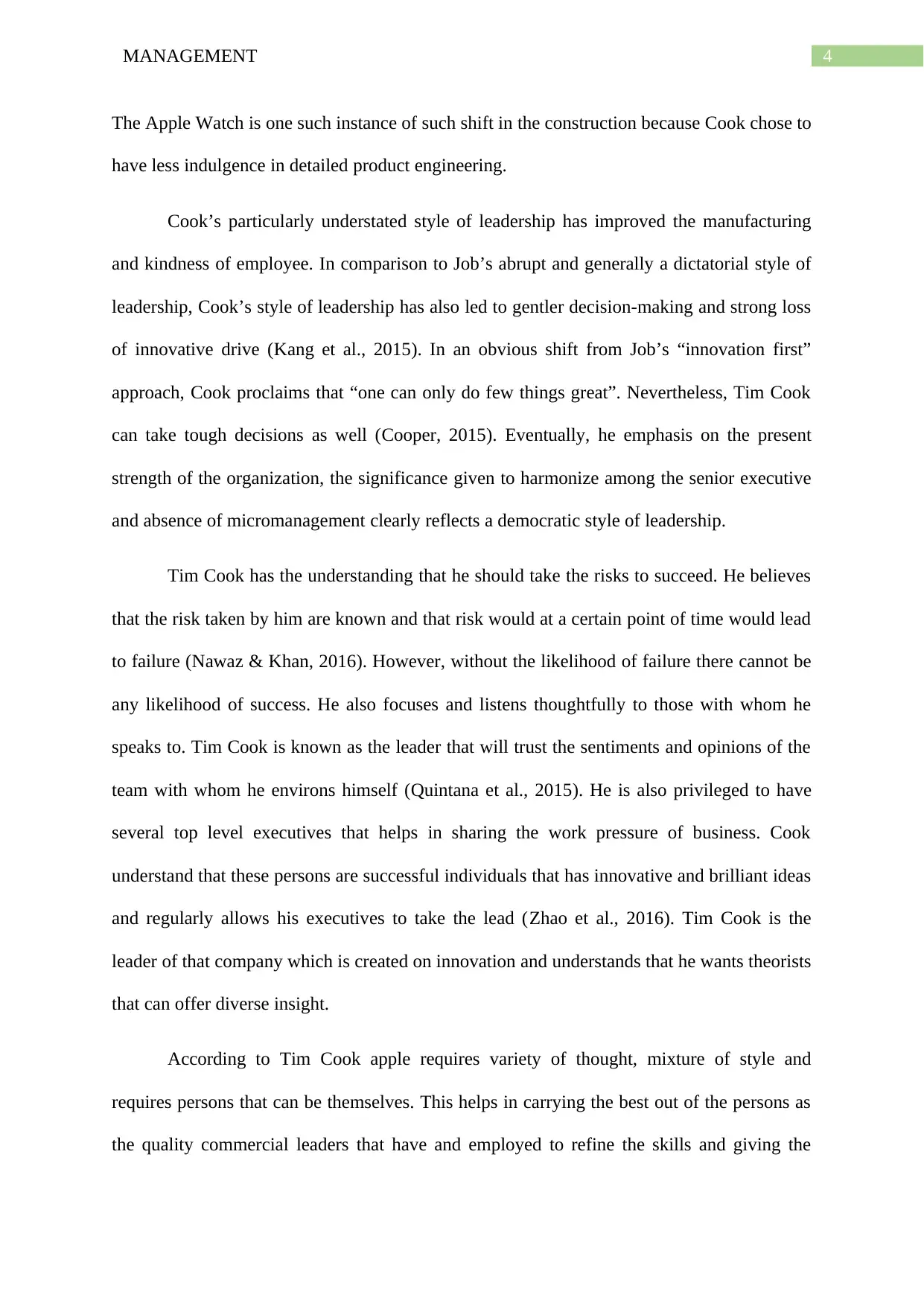
4MANAGEMENT
The Apple Watch is one such instance of such shift in the construction because Cook chose to
have less indulgence in detailed product engineering.
Cook’s particularly understated style of leadership has improved the manufacturing
and kindness of employee. In comparison to Job’s abrupt and generally a dictatorial style of
leadership, Cook’s style of leadership has also led to gentler decision-making and strong loss
of innovative drive (Kang et al., 2015). In an obvious shift from Job’s “innovation first”
approach, Cook proclaims that “one can only do few things great”. Nevertheless, Tim Cook
can take tough decisions as well (Cooper, 2015). Eventually, he emphasis on the present
strength of the organization, the significance given to harmonize among the senior executive
and absence of micromanagement clearly reflects a democratic style of leadership.
Tim Cook has the understanding that he should take the risks to succeed. He believes
that the risk taken by him are known and that risk would at a certain point of time would lead
to failure (Nawaz & Khan, 2016). However, without the likelihood of failure there cannot be
any likelihood of success. He also focuses and listens thoughtfully to those with whom he
speaks to. Tim Cook is known as the leader that will trust the sentiments and opinions of the
team with whom he environs himself (Quintana et al., 2015). He is also privileged to have
several top level executives that helps in sharing the work pressure of business. Cook
understand that these persons are successful individuals that has innovative and brilliant ideas
and regularly allows his executives to take the lead (Zhao et al., 2016). Tim Cook is the
leader of that company which is created on innovation and understands that he wants theorists
that can offer diverse insight.
According to Tim Cook apple requires variety of thought, mixture of style and
requires persons that can be themselves. This helps in carrying the best out of the persons as
the quality commercial leaders that have and employed to refine the skills and giving the
The Apple Watch is one such instance of such shift in the construction because Cook chose to
have less indulgence in detailed product engineering.
Cook’s particularly understated style of leadership has improved the manufacturing
and kindness of employee. In comparison to Job’s abrupt and generally a dictatorial style of
leadership, Cook’s style of leadership has also led to gentler decision-making and strong loss
of innovative drive (Kang et al., 2015). In an obvious shift from Job’s “innovation first”
approach, Cook proclaims that “one can only do few things great”. Nevertheless, Tim Cook
can take tough decisions as well (Cooper, 2015). Eventually, he emphasis on the present
strength of the organization, the significance given to harmonize among the senior executive
and absence of micromanagement clearly reflects a democratic style of leadership.
Tim Cook has the understanding that he should take the risks to succeed. He believes
that the risk taken by him are known and that risk would at a certain point of time would lead
to failure (Nawaz & Khan, 2016). However, without the likelihood of failure there cannot be
any likelihood of success. He also focuses and listens thoughtfully to those with whom he
speaks to. Tim Cook is known as the leader that will trust the sentiments and opinions of the
team with whom he environs himself (Quintana et al., 2015). He is also privileged to have
several top level executives that helps in sharing the work pressure of business. Cook
understand that these persons are successful individuals that has innovative and brilliant ideas
and regularly allows his executives to take the lead (Zhao et al., 2016). Tim Cook is the
leader of that company which is created on innovation and understands that he wants theorists
that can offer diverse insight.
According to Tim Cook apple requires variety of thought, mixture of style and
requires persons that can be themselves. This helps in carrying the best out of the persons as
the quality commercial leaders that have and employed to refine the skills and giving the
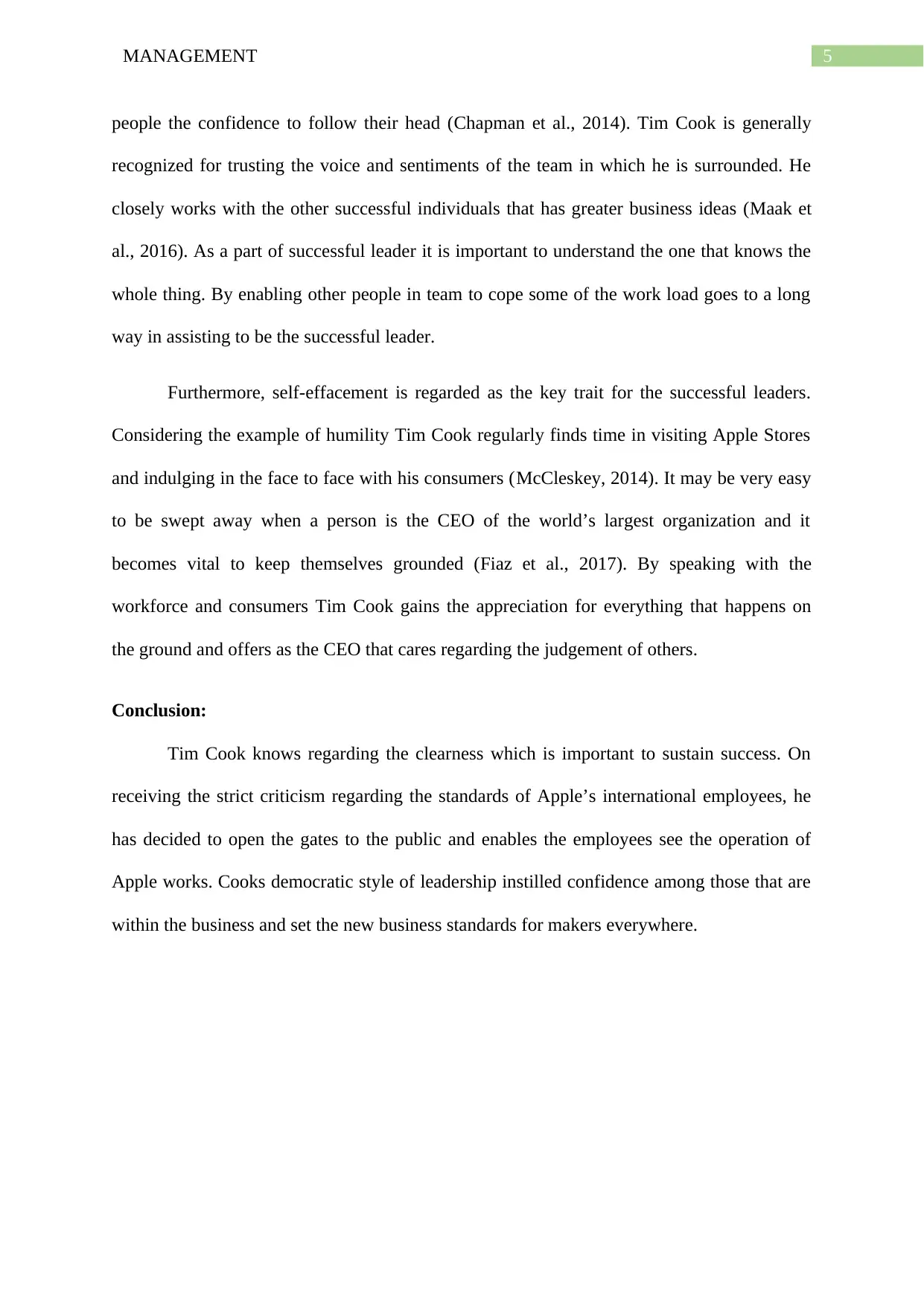
5MANAGEMENT
people the confidence to follow their head (Chapman et al., 2014). Tim Cook is generally
recognized for trusting the voice and sentiments of the team in which he is surrounded. He
closely works with the other successful individuals that has greater business ideas (Maak et
al., 2016). As a part of successful leader it is important to understand the one that knows the
whole thing. By enabling other people in team to cope some of the work load goes to a long
way in assisting to be the successful leader.
Furthermore, self-effacement is regarded as the key trait for the successful leaders.
Considering the example of humility Tim Cook regularly finds time in visiting Apple Stores
and indulging in the face to face with his consumers (McCleskey, 2014). It may be very easy
to be swept away when a person is the CEO of the world’s largest organization and it
becomes vital to keep themselves grounded (Fiaz et al., 2017). By speaking with the
workforce and consumers Tim Cook gains the appreciation for everything that happens on
the ground and offers as the CEO that cares regarding the judgement of others.
Conclusion:
Tim Cook knows regarding the clearness which is important to sustain success. On
receiving the strict criticism regarding the standards of Apple’s international employees, he
has decided to open the gates to the public and enables the employees see the operation of
Apple works. Cooks democratic style of leadership instilled confidence among those that are
within the business and set the new business standards for makers everywhere.
people the confidence to follow their head (Chapman et al., 2014). Tim Cook is generally
recognized for trusting the voice and sentiments of the team in which he is surrounded. He
closely works with the other successful individuals that has greater business ideas (Maak et
al., 2016). As a part of successful leader it is important to understand the one that knows the
whole thing. By enabling other people in team to cope some of the work load goes to a long
way in assisting to be the successful leader.
Furthermore, self-effacement is regarded as the key trait for the successful leaders.
Considering the example of humility Tim Cook regularly finds time in visiting Apple Stores
and indulging in the face to face with his consumers (McCleskey, 2014). It may be very easy
to be swept away when a person is the CEO of the world’s largest organization and it
becomes vital to keep themselves grounded (Fiaz et al., 2017). By speaking with the
workforce and consumers Tim Cook gains the appreciation for everything that happens on
the ground and offers as the CEO that cares regarding the judgement of others.
Conclusion:
Tim Cook knows regarding the clearness which is important to sustain success. On
receiving the strict criticism regarding the standards of Apple’s international employees, he
has decided to open the gates to the public and enables the employees see the operation of
Apple works. Cooks democratic style of leadership instilled confidence among those that are
within the business and set the new business standards for makers everywhere.
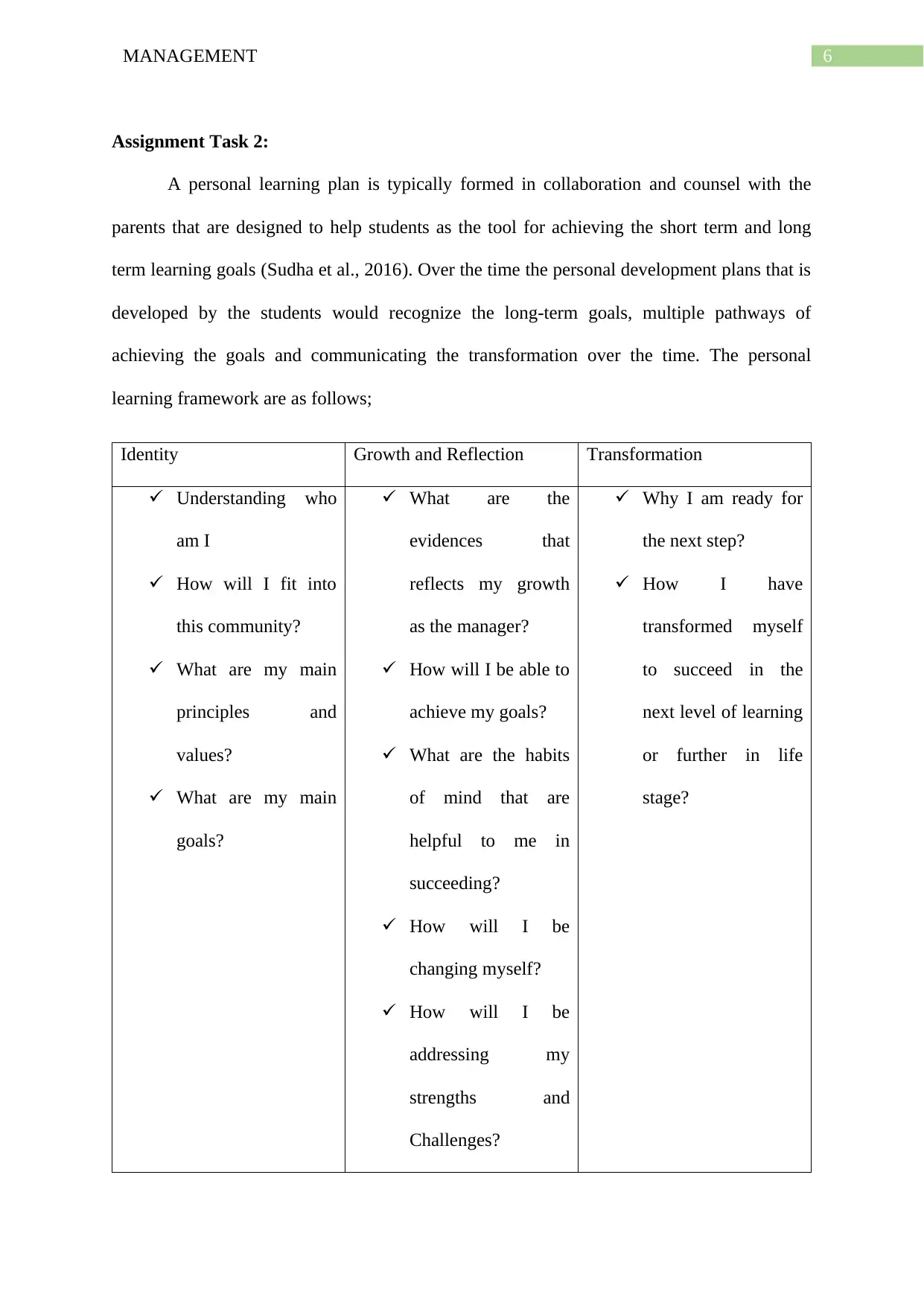
6MANAGEMENT
Assignment Task 2:
A personal learning plan is typically formed in collaboration and counsel with the
parents that are designed to help students as the tool for achieving the short term and long
term learning goals (Sudha et al., 2016). Over the time the personal development plans that is
developed by the students would recognize the long-term goals, multiple pathways of
achieving the goals and communicating the transformation over the time. The personal
learning framework are as follows;
Identity Growth and Reflection Transformation
Understanding who
am I
How will I fit into
this community?
What are my main
principles and
values?
What are my main
goals?
What are the
evidences that
reflects my growth
as the manager?
How will I be able to
achieve my goals?
What are the habits
of mind that are
helpful to me in
succeeding?
How will I be
changing myself?
How will I be
addressing my
strengths and
Challenges?
Why I am ready for
the next step?
How I have
transformed myself
to succeed in the
next level of learning
or further in life
stage?
Assignment Task 2:
A personal learning plan is typically formed in collaboration and counsel with the
parents that are designed to help students as the tool for achieving the short term and long
term learning goals (Sudha et al., 2016). Over the time the personal development plans that is
developed by the students would recognize the long-term goals, multiple pathways of
achieving the goals and communicating the transformation over the time. The personal
learning framework are as follows;
Identity Growth and Reflection Transformation
Understanding who
am I
How will I fit into
this community?
What are my main
principles and
values?
What are my main
goals?
What are the
evidences that
reflects my growth
as the manager?
How will I be able to
achieve my goals?
What are the habits
of mind that are
helpful to me in
succeeding?
How will I be
changing myself?
How will I be
addressing my
strengths and
Challenges?
Why I am ready for
the next step?
How I have
transformed myself
to succeed in the
next level of learning
or further in life
stage?
Paraphrase This Document
Need a fresh take? Get an instant paraphrase of this document with our AI Paraphraser
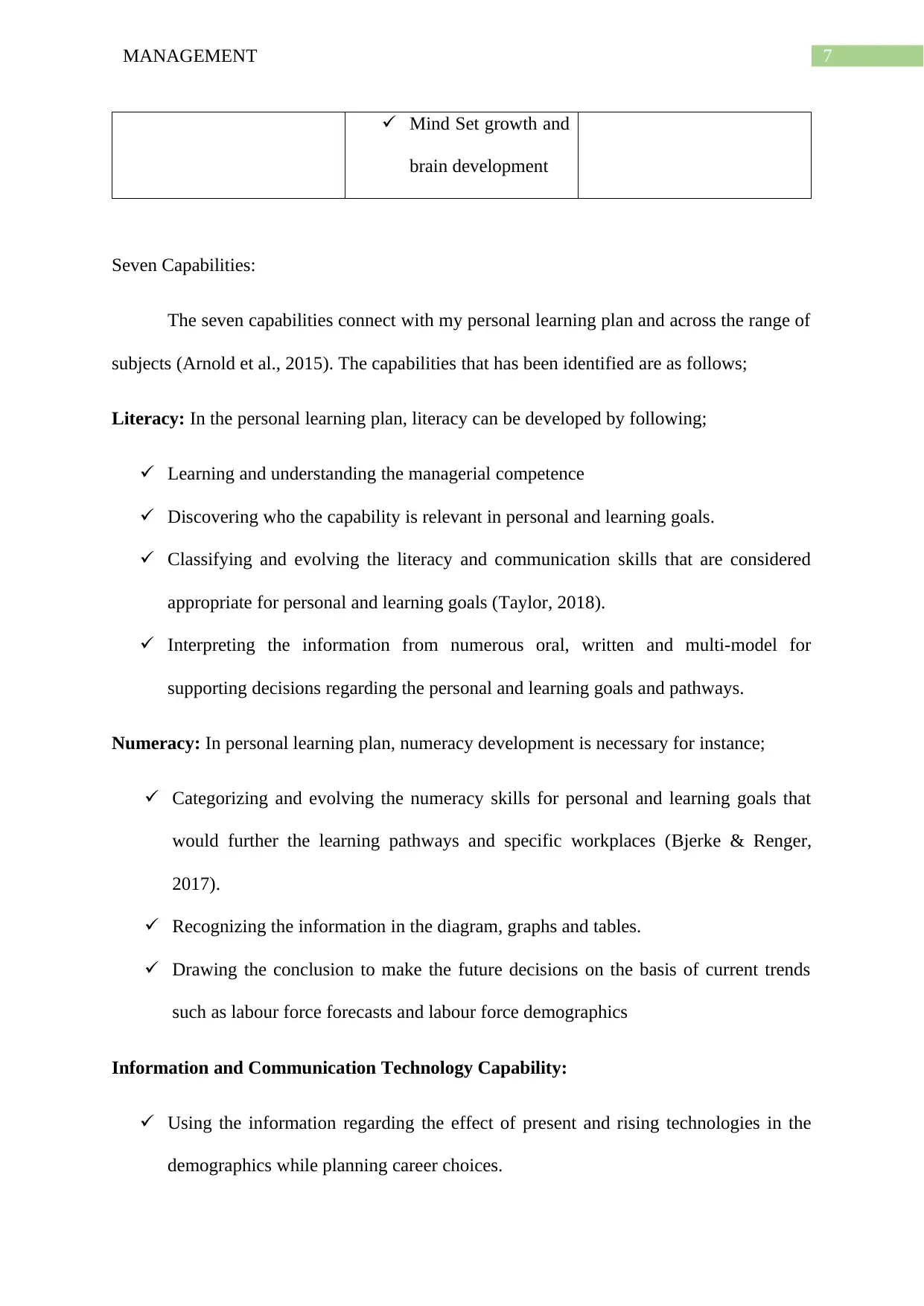
7MANAGEMENT
Mind Set growth and
brain development
Seven Capabilities:
The seven capabilities connect with my personal learning plan and across the range of
subjects (Arnold et al., 2015). The capabilities that has been identified are as follows;
Literacy: In the personal learning plan, literacy can be developed by following;
Learning and understanding the managerial competence
Discovering who the capability is relevant in personal and learning goals.
Classifying and evolving the literacy and communication skills that are considered
appropriate for personal and learning goals (Taylor, 2018).
Interpreting the information from numerous oral, written and multi-model for
supporting decisions regarding the personal and learning goals and pathways.
Numeracy: In personal learning plan, numeracy development is necessary for instance;
Categorizing and evolving the numeracy skills for personal and learning goals that
would further the learning pathways and specific workplaces (Bjerke & Renger,
2017).
Recognizing the information in the diagram, graphs and tables.
Drawing the conclusion to make the future decisions on the basis of current trends
such as labour force forecasts and labour force demographics
Information and Communication Technology Capability:
Using the information regarding the effect of present and rising technologies in the
demographics while planning career choices.
Mind Set growth and
brain development
Seven Capabilities:
The seven capabilities connect with my personal learning plan and across the range of
subjects (Arnold et al., 2015). The capabilities that has been identified are as follows;
Literacy: In the personal learning plan, literacy can be developed by following;
Learning and understanding the managerial competence
Discovering who the capability is relevant in personal and learning goals.
Classifying and evolving the literacy and communication skills that are considered
appropriate for personal and learning goals (Taylor, 2018).
Interpreting the information from numerous oral, written and multi-model for
supporting decisions regarding the personal and learning goals and pathways.
Numeracy: In personal learning plan, numeracy development is necessary for instance;
Categorizing and evolving the numeracy skills for personal and learning goals that
would further the learning pathways and specific workplaces (Bjerke & Renger,
2017).
Recognizing the information in the diagram, graphs and tables.
Drawing the conclusion to make the future decisions on the basis of current trends
such as labour force forecasts and labour force demographics
Information and Communication Technology Capability:
Using the information regarding the effect of present and rising technologies in the
demographics while planning career choices.
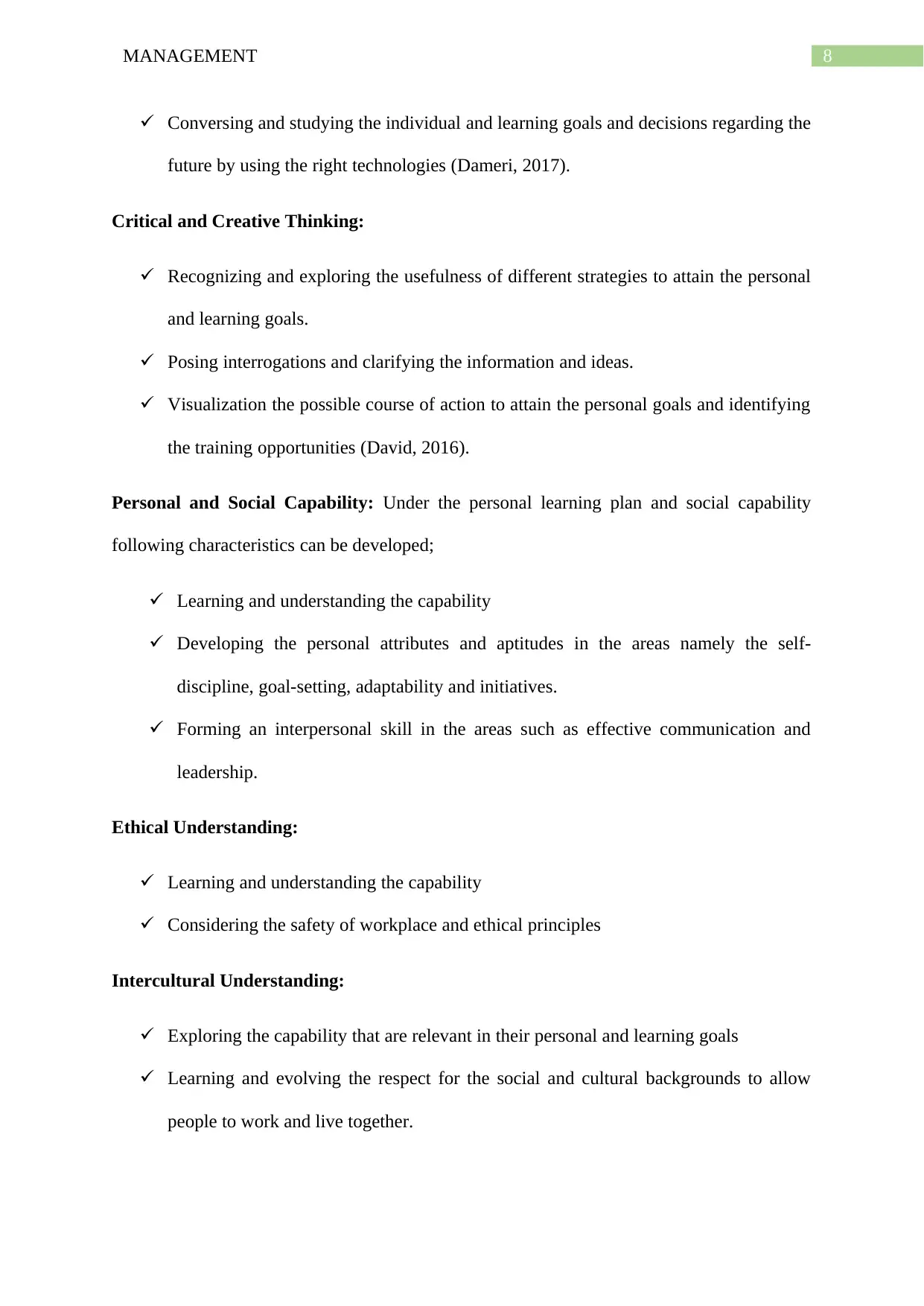
8MANAGEMENT
Conversing and studying the individual and learning goals and decisions regarding the
future by using the right technologies (Dameri, 2017).
Critical and Creative Thinking:
Recognizing and exploring the usefulness of different strategies to attain the personal
and learning goals.
Posing interrogations and clarifying the information and ideas.
Visualization the possible course of action to attain the personal goals and identifying
the training opportunities (David, 2016).
Personal and Social Capability: Under the personal learning plan and social capability
following characteristics can be developed;
Learning and understanding the capability
Developing the personal attributes and aptitudes in the areas namely the self-
discipline, goal-setting, adaptability and initiatives.
Forming an interpersonal skill in the areas such as effective communication and
leadership.
Ethical Understanding:
Learning and understanding the capability
Considering the safety of workplace and ethical principles
Intercultural Understanding:
Exploring the capability that are relevant in their personal and learning goals
Learning and evolving the respect for the social and cultural backgrounds to allow
people to work and live together.
Conversing and studying the individual and learning goals and decisions regarding the
future by using the right technologies (Dameri, 2017).
Critical and Creative Thinking:
Recognizing and exploring the usefulness of different strategies to attain the personal
and learning goals.
Posing interrogations and clarifying the information and ideas.
Visualization the possible course of action to attain the personal goals and identifying
the training opportunities (David, 2016).
Personal and Social Capability: Under the personal learning plan and social capability
following characteristics can be developed;
Learning and understanding the capability
Developing the personal attributes and aptitudes in the areas namely the self-
discipline, goal-setting, adaptability and initiatives.
Forming an interpersonal skill in the areas such as effective communication and
leadership.
Ethical Understanding:
Learning and understanding the capability
Considering the safety of workplace and ethical principles
Intercultural Understanding:
Exploring the capability that are relevant in their personal and learning goals
Learning and evolving the respect for the social and cultural backgrounds to allow
people to work and live together.
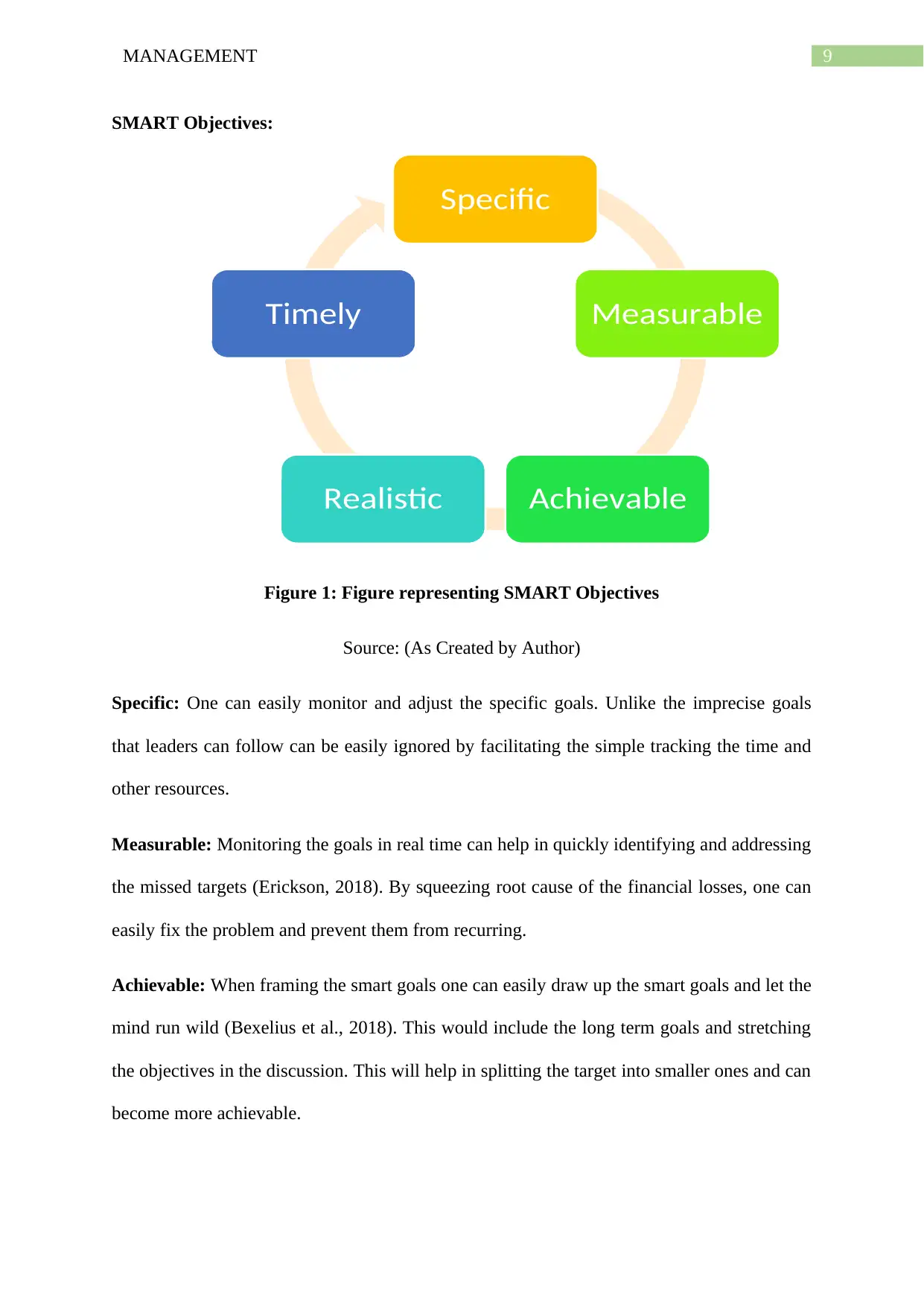
9MANAGEMENT
SMART Objectives:
Figure 1: Figure representing SMART Objectives
Source: (As Created by Author)
Specific: One can easily monitor and adjust the specific goals. Unlike the imprecise goals
that leaders can follow can be easily ignored by facilitating the simple tracking the time and
other resources.
Measurable: Monitoring the goals in real time can help in quickly identifying and addressing
the missed targets (Erickson, 2018). By squeezing root cause of the financial losses, one can
easily fix the problem and prevent them from recurring.
Achievable: When framing the smart goals one can easily draw up the smart goals and let the
mind run wild (Bexelius et al., 2018). This would include the long term goals and stretching
the objectives in the discussion. This will help in splitting the target into smaller ones and can
become more achievable.
Specific
Measurable
AchievableRealistic
Timely
SMART Objectives:
Figure 1: Figure representing SMART Objectives
Source: (As Created by Author)
Specific: One can easily monitor and adjust the specific goals. Unlike the imprecise goals
that leaders can follow can be easily ignored by facilitating the simple tracking the time and
other resources.
Measurable: Monitoring the goals in real time can help in quickly identifying and addressing
the missed targets (Erickson, 2018). By squeezing root cause of the financial losses, one can
easily fix the problem and prevent them from recurring.
Achievable: When framing the smart goals one can easily draw up the smart goals and let the
mind run wild (Bexelius et al., 2018). This would include the long term goals and stretching
the objectives in the discussion. This will help in splitting the target into smaller ones and can
become more achievable.
Specific
Measurable
AchievableRealistic
Timely
Secure Best Marks with AI Grader
Need help grading? Try our AI Grader for instant feedback on your assignments.
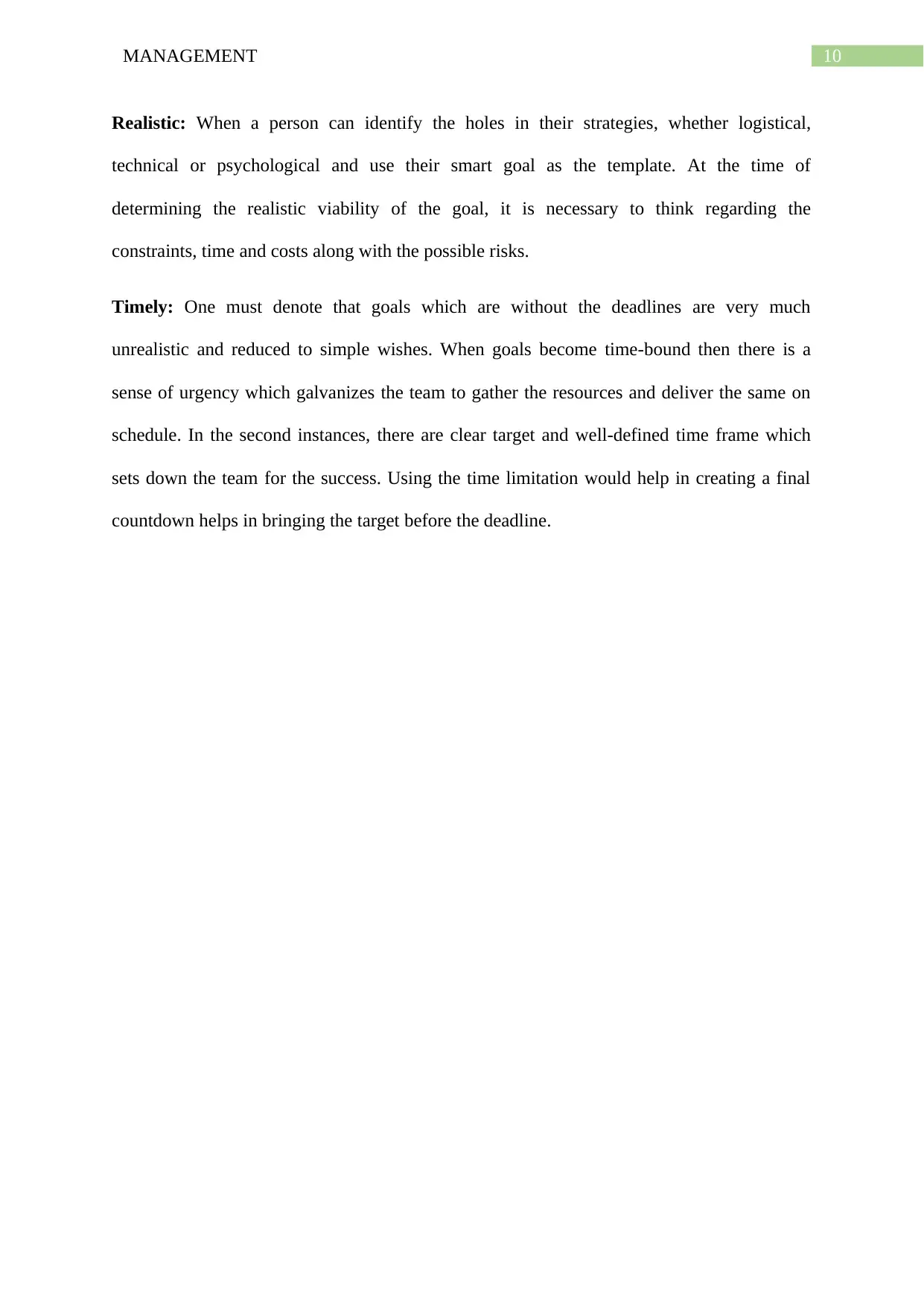
10MANAGEMENT
Realistic: When a person can identify the holes in their strategies, whether logistical,
technical or psychological and use their smart goal as the template. At the time of
determining the realistic viability of the goal, it is necessary to think regarding the
constraints, time and costs along with the possible risks.
Timely: One must denote that goals which are without the deadlines are very much
unrealistic and reduced to simple wishes. When goals become time-bound then there is a
sense of urgency which galvanizes the team to gather the resources and deliver the same on
schedule. In the second instances, there are clear target and well-defined time frame which
sets down the team for the success. Using the time limitation would help in creating a final
countdown helps in bringing the target before the deadline.
Realistic: When a person can identify the holes in their strategies, whether logistical,
technical or psychological and use their smart goal as the template. At the time of
determining the realistic viability of the goal, it is necessary to think regarding the
constraints, time and costs along with the possible risks.
Timely: One must denote that goals which are without the deadlines are very much
unrealistic and reduced to simple wishes. When goals become time-bound then there is a
sense of urgency which galvanizes the team to gather the resources and deliver the same on
schedule. In the second instances, there are clear target and well-defined time frame which
sets down the team for the success. Using the time limitation would help in creating a final
countdown helps in bringing the target before the deadline.
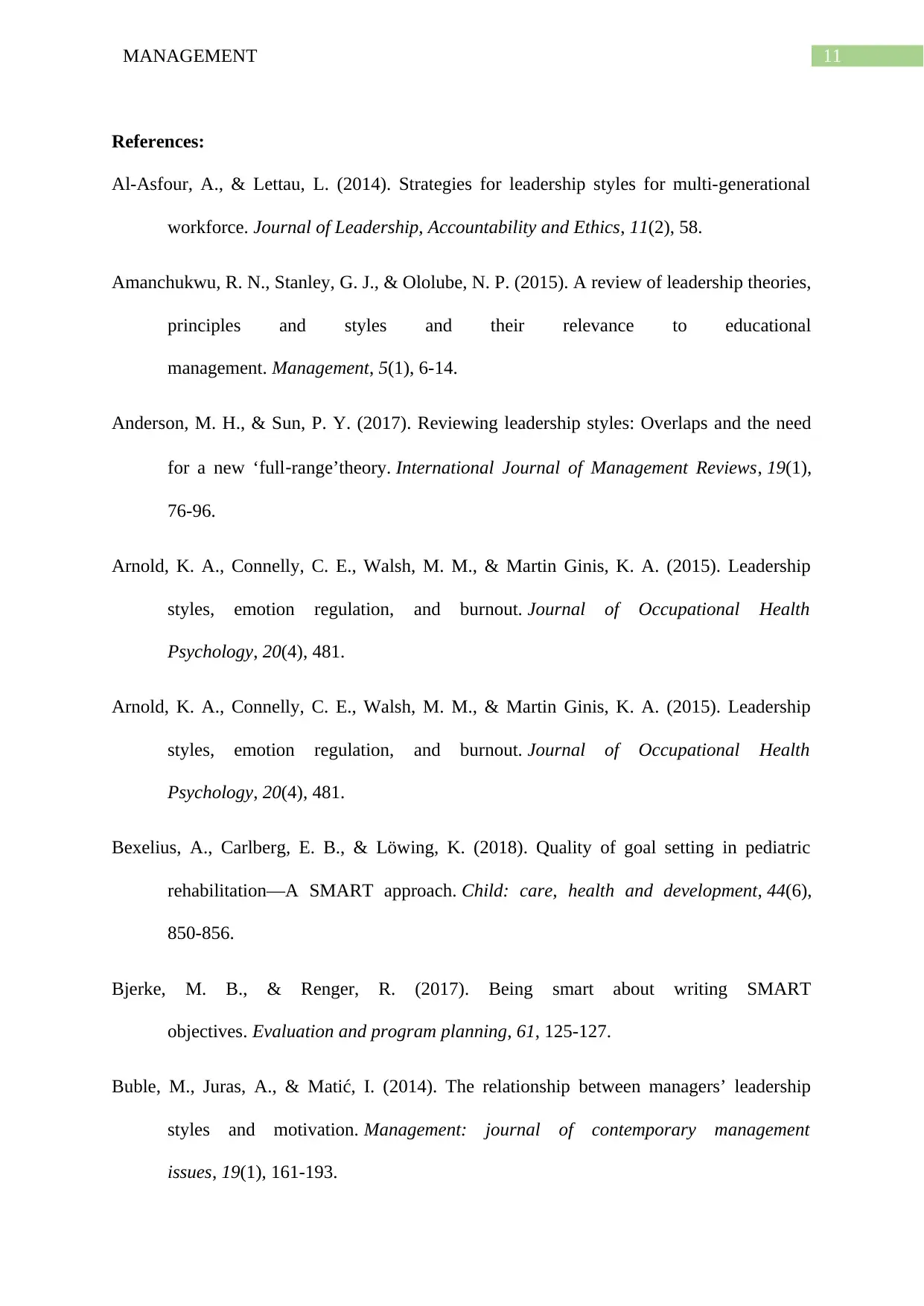
11MANAGEMENT
References:
Al-Asfour, A., & Lettau, L. (2014). Strategies for leadership styles for multi-generational
workforce. Journal of Leadership, Accountability and Ethics, 11(2), 58.
Amanchukwu, R. N., Stanley, G. J., & Ololube, N. P. (2015). A review of leadership theories,
principles and styles and their relevance to educational
management. Management, 5(1), 6-14.
Anderson, M. H., & Sun, P. Y. (2017). Reviewing leadership styles: Overlaps and the need
for a new ‘full‐range’theory. International Journal of Management Reviews, 19(1),
76-96.
Arnold, K. A., Connelly, C. E., Walsh, M. M., & Martin Ginis, K. A. (2015). Leadership
styles, emotion regulation, and burnout. Journal of Occupational Health
Psychology, 20(4), 481.
Arnold, K. A., Connelly, C. E., Walsh, M. M., & Martin Ginis, K. A. (2015). Leadership
styles, emotion regulation, and burnout. Journal of Occupational Health
Psychology, 20(4), 481.
Bexelius, A., Carlberg, E. B., & Löwing, K. (2018). Quality of goal setting in pediatric
rehabilitation—A SMART approach. Child: care, health and development, 44(6),
850-856.
Bjerke, M. B., & Renger, R. (2017). Being smart about writing SMART
objectives. Evaluation and program planning, 61, 125-127.
Buble, M., Juras, A., & Matić, I. (2014). The relationship between managers’ leadership
styles and motivation. Management: journal of contemporary management
issues, 19(1), 161-193.
References:
Al-Asfour, A., & Lettau, L. (2014). Strategies for leadership styles for multi-generational
workforce. Journal of Leadership, Accountability and Ethics, 11(2), 58.
Amanchukwu, R. N., Stanley, G. J., & Ololube, N. P. (2015). A review of leadership theories,
principles and styles and their relevance to educational
management. Management, 5(1), 6-14.
Anderson, M. H., & Sun, P. Y. (2017). Reviewing leadership styles: Overlaps and the need
for a new ‘full‐range’theory. International Journal of Management Reviews, 19(1),
76-96.
Arnold, K. A., Connelly, C. E., Walsh, M. M., & Martin Ginis, K. A. (2015). Leadership
styles, emotion regulation, and burnout. Journal of Occupational Health
Psychology, 20(4), 481.
Arnold, K. A., Connelly, C. E., Walsh, M. M., & Martin Ginis, K. A. (2015). Leadership
styles, emotion regulation, and burnout. Journal of Occupational Health
Psychology, 20(4), 481.
Bexelius, A., Carlberg, E. B., & Löwing, K. (2018). Quality of goal setting in pediatric
rehabilitation—A SMART approach. Child: care, health and development, 44(6),
850-856.
Bjerke, M. B., & Renger, R. (2017). Being smart about writing SMART
objectives. Evaluation and program planning, 61, 125-127.
Buble, M., Juras, A., & Matić, I. (2014). The relationship between managers’ leadership
styles and motivation. Management: journal of contemporary management
issues, 19(1), 161-193.
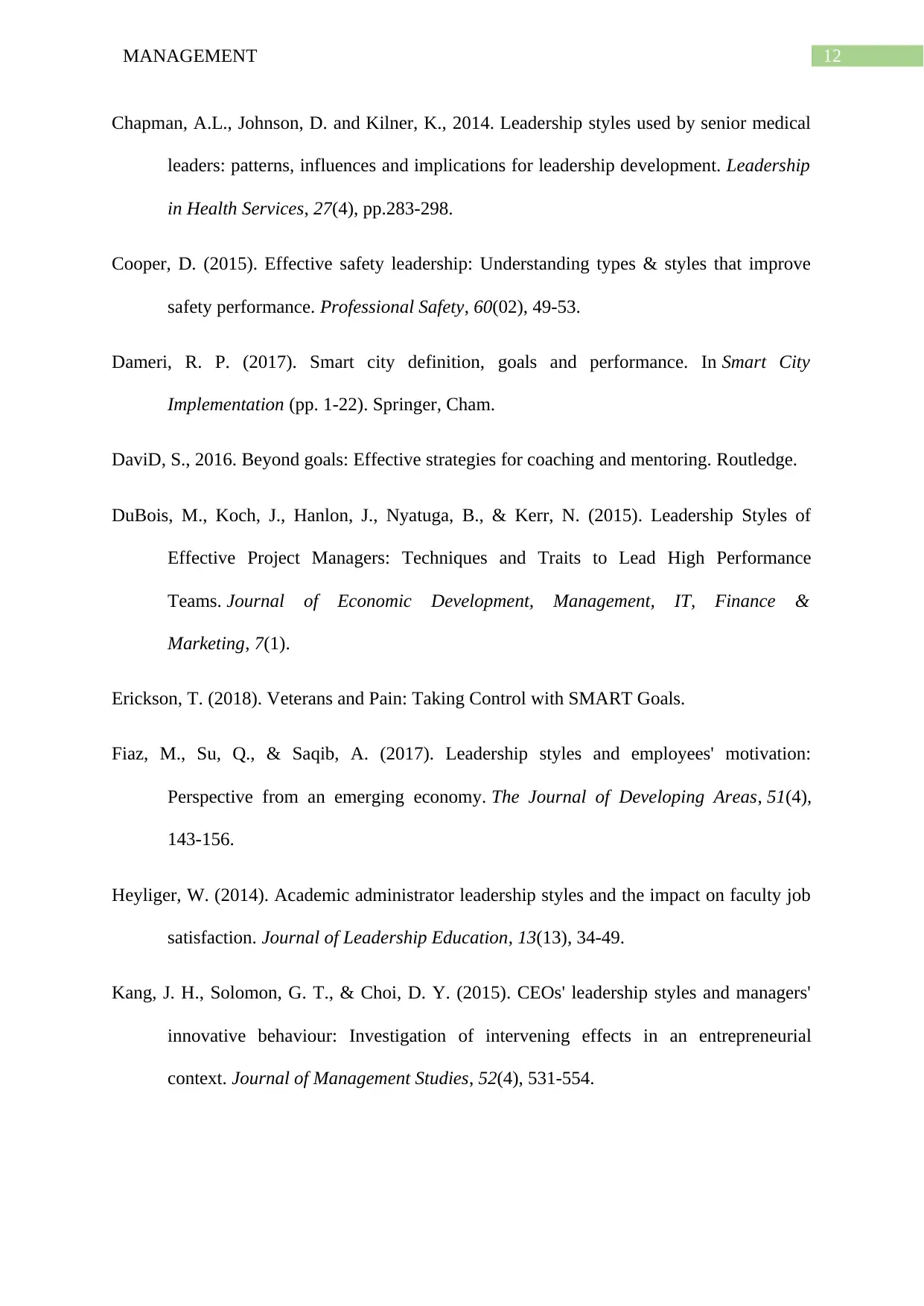
12MANAGEMENT
Chapman, A.L., Johnson, D. and Kilner, K., 2014. Leadership styles used by senior medical
leaders: patterns, influences and implications for leadership development. Leadership
in Health Services, 27(4), pp.283-298.
Cooper, D. (2015). Effective safety leadership: Understanding types & styles that improve
safety performance. Professional Safety, 60(02), 49-53.
Dameri, R. P. (2017). Smart city definition, goals and performance. In Smart City
Implementation (pp. 1-22). Springer, Cham.
DaviD, S., 2016. Beyond goals: Effective strategies for coaching and mentoring. Routledge.
DuBois, M., Koch, J., Hanlon, J., Nyatuga, B., & Kerr, N. (2015). Leadership Styles of
Effective Project Managers: Techniques and Traits to Lead High Performance
Teams. Journal of Economic Development, Management, IT, Finance &
Marketing, 7(1).
Erickson, T. (2018). Veterans and Pain: Taking Control with SMART Goals.
Fiaz, M., Su, Q., & Saqib, A. (2017). Leadership styles and employees' motivation:
Perspective from an emerging economy. The Journal of Developing Areas, 51(4),
143-156.
Heyliger, W. (2014). Academic administrator leadership styles and the impact on faculty job
satisfaction. Journal of Leadership Education, 13(13), 34-49.
Kang, J. H., Solomon, G. T., & Choi, D. Y. (2015). CEOs' leadership styles and managers'
innovative behaviour: Investigation of intervening effects in an entrepreneurial
context. Journal of Management Studies, 52(4), 531-554.
Chapman, A.L., Johnson, D. and Kilner, K., 2014. Leadership styles used by senior medical
leaders: patterns, influences and implications for leadership development. Leadership
in Health Services, 27(4), pp.283-298.
Cooper, D. (2015). Effective safety leadership: Understanding types & styles that improve
safety performance. Professional Safety, 60(02), 49-53.
Dameri, R. P. (2017). Smart city definition, goals and performance. In Smart City
Implementation (pp. 1-22). Springer, Cham.
DaviD, S., 2016. Beyond goals: Effective strategies for coaching and mentoring. Routledge.
DuBois, M., Koch, J., Hanlon, J., Nyatuga, B., & Kerr, N. (2015). Leadership Styles of
Effective Project Managers: Techniques and Traits to Lead High Performance
Teams. Journal of Economic Development, Management, IT, Finance &
Marketing, 7(1).
Erickson, T. (2018). Veterans and Pain: Taking Control with SMART Goals.
Fiaz, M., Su, Q., & Saqib, A. (2017). Leadership styles and employees' motivation:
Perspective from an emerging economy. The Journal of Developing Areas, 51(4),
143-156.
Heyliger, W. (2014). Academic administrator leadership styles and the impact on faculty job
satisfaction. Journal of Leadership Education, 13(13), 34-49.
Kang, J. H., Solomon, G. T., & Choi, D. Y. (2015). CEOs' leadership styles and managers'
innovative behaviour: Investigation of intervening effects in an entrepreneurial
context. Journal of Management Studies, 52(4), 531-554.
Paraphrase This Document
Need a fresh take? Get an instant paraphrase of this document with our AI Paraphraser
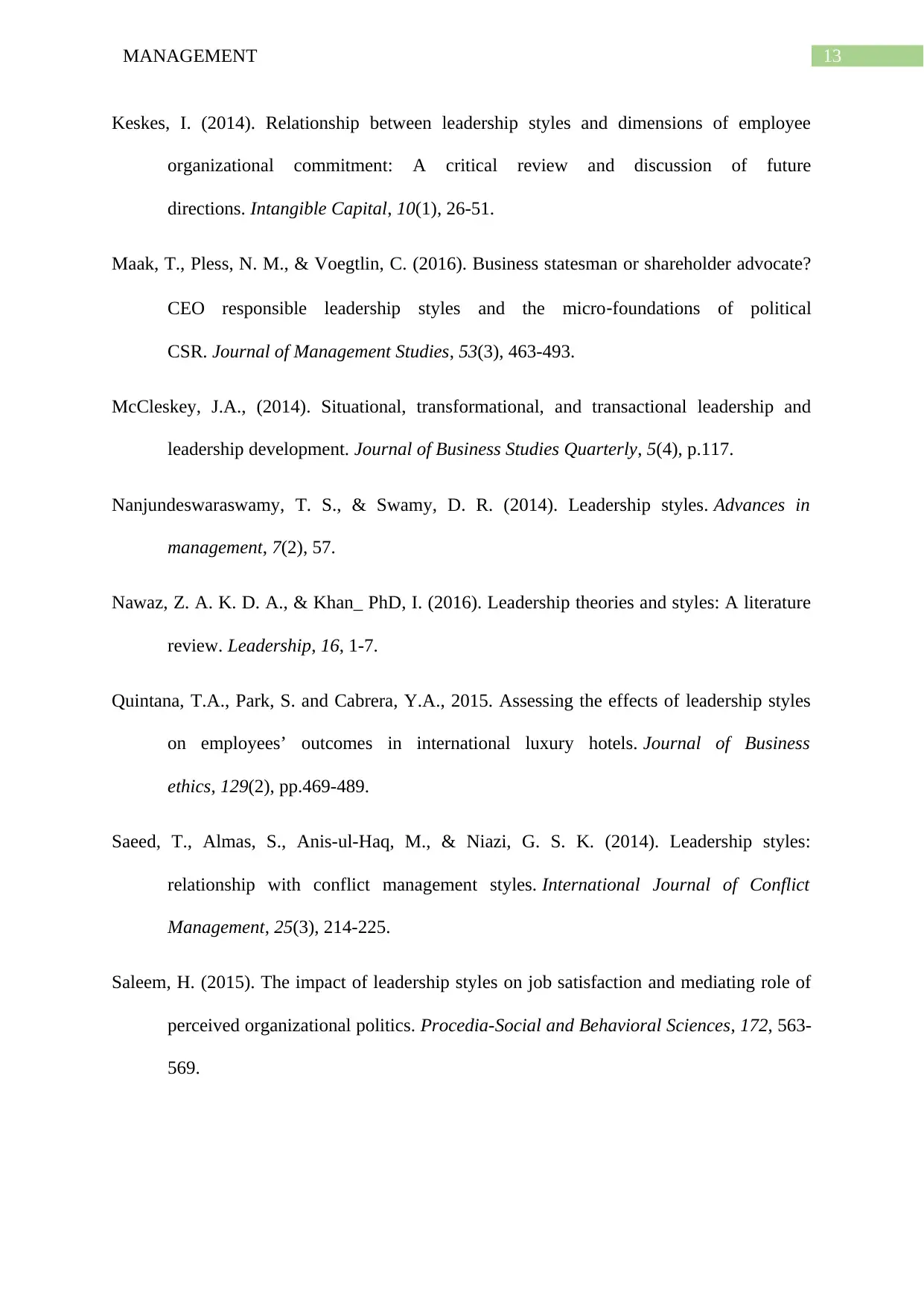
13MANAGEMENT
Keskes, I. (2014). Relationship between leadership styles and dimensions of employee
organizational commitment: A critical review and discussion of future
directions. Intangible Capital, 10(1), 26-51.
Maak, T., Pless, N. M., & Voegtlin, C. (2016). Business statesman or shareholder advocate?
CEO responsible leadership styles and the micro‐foundations of political
CSR. Journal of Management Studies, 53(3), 463-493.
McCleskey, J.A., (2014). Situational, transformational, and transactional leadership and
leadership development. Journal of Business Studies Quarterly, 5(4), p.117.
Nanjundeswaraswamy, T. S., & Swamy, D. R. (2014). Leadership styles. Advances in
management, 7(2), 57.
Nawaz, Z. A. K. D. A., & Khan_ PhD, I. (2016). Leadership theories and styles: A literature
review. Leadership, 16, 1-7.
Quintana, T.A., Park, S. and Cabrera, Y.A., 2015. Assessing the effects of leadership styles
on employees’ outcomes in international luxury hotels. Journal of Business
ethics, 129(2), pp.469-489.
Saeed, T., Almas, S., Anis-ul-Haq, M., & Niazi, G. S. K. (2014). Leadership styles:
relationship with conflict management styles. International Journal of Conflict
Management, 25(3), 214-225.
Saleem, H. (2015). The impact of leadership styles on job satisfaction and mediating role of
perceived organizational politics. Procedia-Social and Behavioral Sciences, 172, 563-
569.
Keskes, I. (2014). Relationship between leadership styles and dimensions of employee
organizational commitment: A critical review and discussion of future
directions. Intangible Capital, 10(1), 26-51.
Maak, T., Pless, N. M., & Voegtlin, C. (2016). Business statesman or shareholder advocate?
CEO responsible leadership styles and the micro‐foundations of political
CSR. Journal of Management Studies, 53(3), 463-493.
McCleskey, J.A., (2014). Situational, transformational, and transactional leadership and
leadership development. Journal of Business Studies Quarterly, 5(4), p.117.
Nanjundeswaraswamy, T. S., & Swamy, D. R. (2014). Leadership styles. Advances in
management, 7(2), 57.
Nawaz, Z. A. K. D. A., & Khan_ PhD, I. (2016). Leadership theories and styles: A literature
review. Leadership, 16, 1-7.
Quintana, T.A., Park, S. and Cabrera, Y.A., 2015. Assessing the effects of leadership styles
on employees’ outcomes in international luxury hotels. Journal of Business
ethics, 129(2), pp.469-489.
Saeed, T., Almas, S., Anis-ul-Haq, M., & Niazi, G. S. K. (2014). Leadership styles:
relationship with conflict management styles. International Journal of Conflict
Management, 25(3), 214-225.
Saleem, H. (2015). The impact of leadership styles on job satisfaction and mediating role of
perceived organizational politics. Procedia-Social and Behavioral Sciences, 172, 563-
569.
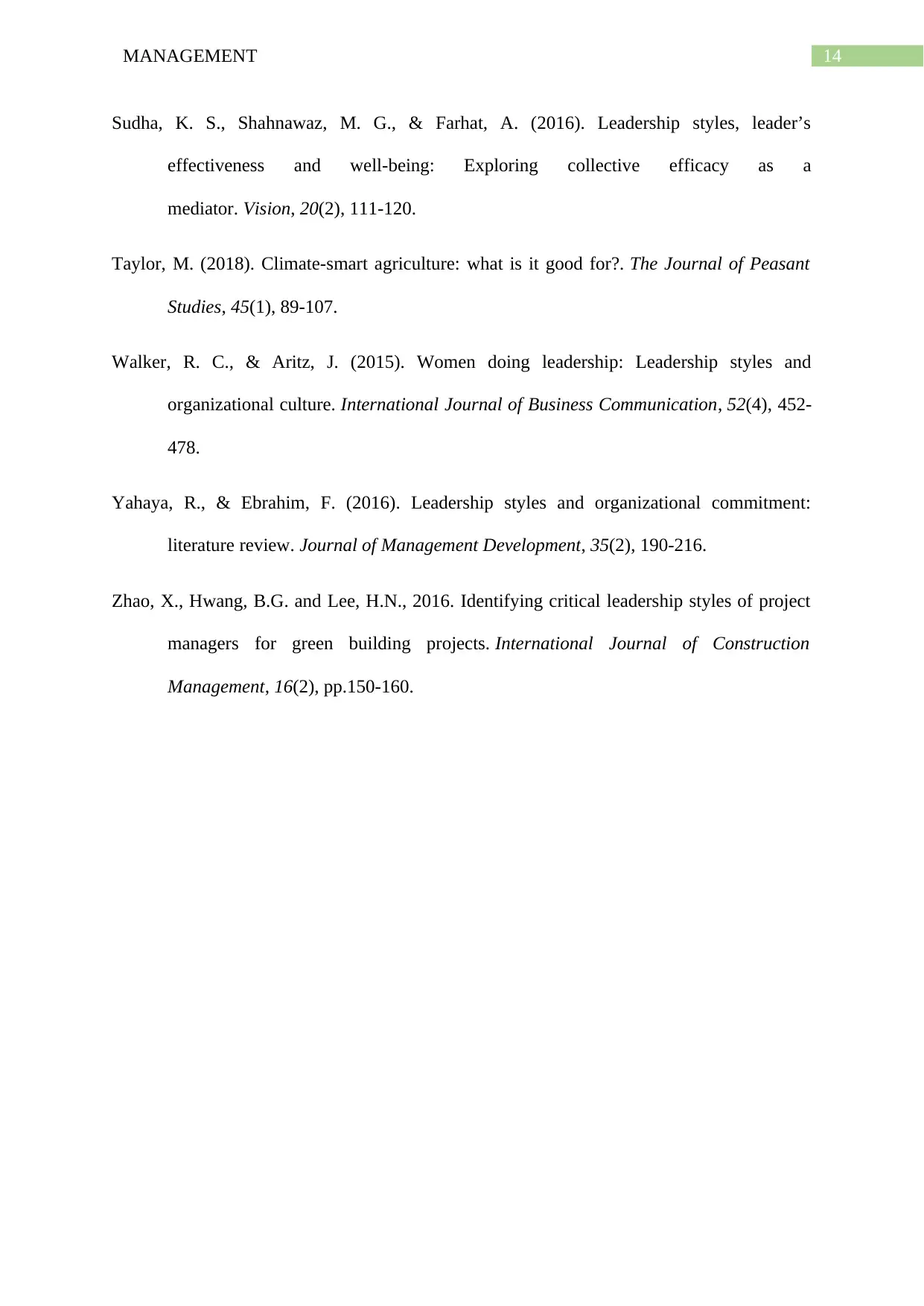
14MANAGEMENT
Sudha, K. S., Shahnawaz, M. G., & Farhat, A. (2016). Leadership styles, leader’s
effectiveness and well-being: Exploring collective efficacy as a
mediator. Vision, 20(2), 111-120.
Taylor, M. (2018). Climate-smart agriculture: what is it good for?. The Journal of Peasant
Studies, 45(1), 89-107.
Walker, R. C., & Aritz, J. (2015). Women doing leadership: Leadership styles and
organizational culture. International Journal of Business Communication, 52(4), 452-
478.
Yahaya, R., & Ebrahim, F. (2016). Leadership styles and organizational commitment:
literature review. Journal of Management Development, 35(2), 190-216.
Zhao, X., Hwang, B.G. and Lee, H.N., 2016. Identifying critical leadership styles of project
managers for green building projects. International Journal of Construction
Management, 16(2), pp.150-160.
Sudha, K. S., Shahnawaz, M. G., & Farhat, A. (2016). Leadership styles, leader’s
effectiveness and well-being: Exploring collective efficacy as a
mediator. Vision, 20(2), 111-120.
Taylor, M. (2018). Climate-smart agriculture: what is it good for?. The Journal of Peasant
Studies, 45(1), 89-107.
Walker, R. C., & Aritz, J. (2015). Women doing leadership: Leadership styles and
organizational culture. International Journal of Business Communication, 52(4), 452-
478.
Yahaya, R., & Ebrahim, F. (2016). Leadership styles and organizational commitment:
literature review. Journal of Management Development, 35(2), 190-216.
Zhao, X., Hwang, B.G. and Lee, H.N., 2016. Identifying critical leadership styles of project
managers for green building projects. International Journal of Construction
Management, 16(2), pp.150-160.
1 out of 15
Related Documents
Your All-in-One AI-Powered Toolkit for Academic Success.
+13062052269
info@desklib.com
Available 24*7 on WhatsApp / Email
![[object Object]](/_next/static/media/star-bottom.7253800d.svg)
Unlock your academic potential
© 2024 | Zucol Services PVT LTD | All rights reserved.





